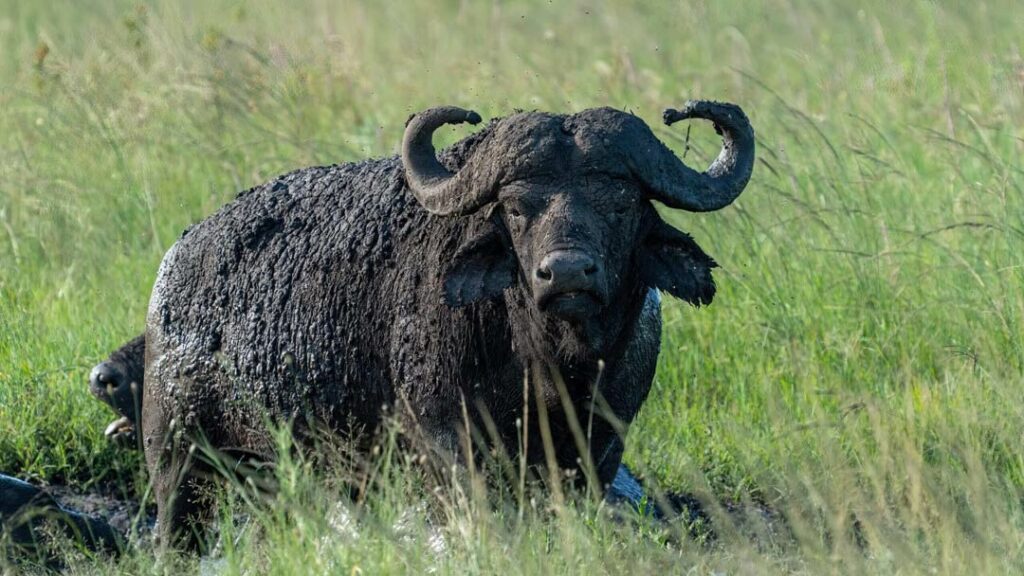Let’s be honest: Nothing is more exciting than spending a month preparing for your choice of an African big game hunt! With the remarkable variety of species in Namibia, it is an extraordinary game hunting destination. Excitement and nervousness before the hunt, and counting down the days until D-Day, keep you going! The overall trip isn’t just about the trophy hunting in Africa that gets done, but also about the beautiful bush views and the memories created while relaxing around a bushveld fire with your friends and family around. Any type of game hunting in Namibia will be unforgettable, let alone a big game animal when your adrenaline is pumping, and your nerves are through the roof!
[DYNAMIC-BLOGTABLEOFCONTENT]
Different Species of Buffalo in Africa
The African buffalo (Syncerus caffer) is native to many areas across Africa, and two main subspecies are recognized: Forest/Red buffalo (S. c. nanus) and Savanna Buffalo. The Savanna Buffalo is divided into three different taxonomically recognized groups:
- Southern Savanna/Cape Buffalo (S. c. caffer).
- Central African Savanna Buffalo (S. c. aequinoctialis)
- West African Savanna Buffalo (S. c. brachyceros)

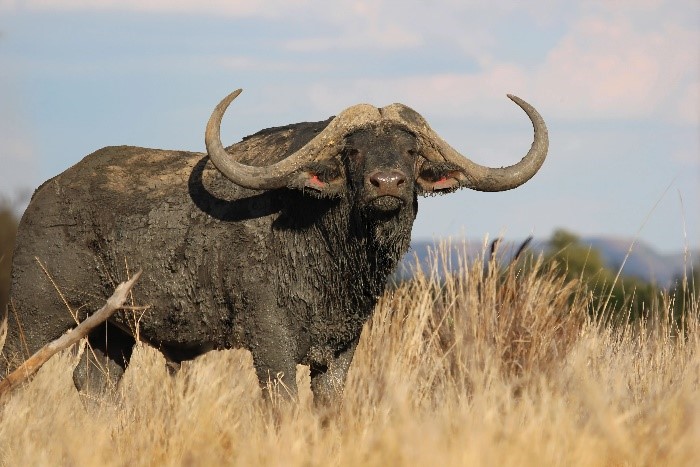
The Forest Buffalos are significantly smaller than other African Buffalos and are reddish-brown with “U”-shaped horns. They only inhabit specific regions within central to western African regions, where they occupy thick forest regions, and savanna regions. They are native to the Democratic Republic of Congo, Northern region of Angola, and western coastal countries of Africa. There is a profound difference in the habitats between Forest Buffalo and Savanna Buffalo, as Forest Buffalo are found along the equatorial line and reside in regions with high humidity and rainfall. Savanna buffalo move between thick vegetation and open savannas according to their feeding schedule and what they on during that specific period. It is a common misconception that buffalos are grazers. All African Buffalo Species are mixed feeders, feeding on grass and leaves. They consume food in bulk with large quantities of roughage. Compared to other ruminants, they consume massive amounts of vegetation daily and process it quickly. As a result of this buffalo droppings or feces, are presented in a thick liquid form and often occur as a “splat” or pile of dung on the ground, forming a hard outer layer first and then solidifying after a couple of hours as the freshness fades.
Southern savanna buffalo and central African savanna buffalo have significantly larger horns, specifically the male buffalo. These buffalo bulls can appear with horns that are wider, deeper, and hold more volume. The body size of these buffalo is roughly the same size between species, where mature males weigh on average 1,84-2,204 pounds and females 1,322-1,433. All species of savanna buffalo appear as a brown-black color. They live in herds of up to a few hundred buffalos and at times, thousands. This large herd population is not a permanent fixture as they occupy a very loose social structure where the herd will break up into smaller herds and later re-join the main herd, due to activities such as mating or calving season. Older, fully mature bulls choose to leave the herd as they are done mating and need to consume more food and pack on even more size. These bulls are characteristically aggressive as they live alone or in small bachelor groups, and their survival depends on their ability to protect themselves. By acting irrationally with aggressive intentions to kill and maul whatever dares to stand in their paths, they improve their survival probability. The big, bad-tempered bulls with even worse attitudes are the type that hunters wish to target during African hunting safaris.
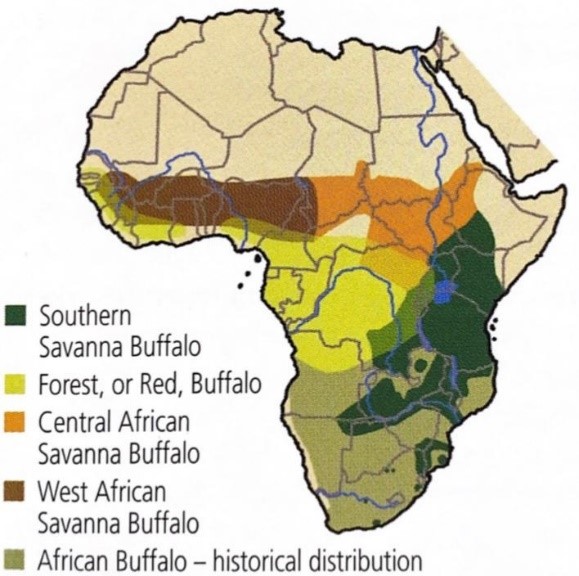
Buffalo Hunting Terrain
Both groups of Forest Buffalo and Savanna Buffalo are true to their name. Forest or red buffalos will only be found naturally in specific sections of dense, thick, humid vegetation, also known as forests. These animals have evolved and adapted to live in these forested areas of central and western Africa, as they have smaller, more compact bodies with unique and beautiful headgear, trademarking their individuality among all other buffalo species. They are specially adapted to feed on this forest vegetation, selectively seeking out specific grasses, trees and shrubs to feed on.
Savanna Buffalo are found in savanna regions. Many people consider the savanna to be wide open grass plains with sparsely distributed trees. This is only true for a savanna habitat specifically. The “savanna” in Savanna Buffalo refers to the savanna biome or savanna bioregion. This includes many individual habitats, such as Mopane Woodlands, where Mopane trees dominate areas and constitute a thick piece of vegetation with limited visibility. Another is the mountainous bushveld regions found within South Africa, a prime destination for buffalo hunting in Africa. There are a variety of other habitats within the savanna biome and bioregion, and you may very well find Savanna Buffalo in any of them. Hunting of savanna buffalo on the savanna plains is as good as it gets for African Buffalo Hunts and is definitely one for the memory books.
The bull with your name on it could just be here, spending his last days walking with the herd before he chooses the bachelor life! Or, your bull could be hidden in the bushveld, using the dense vegetation to his advantage and living a solitary, secretive life.
Buffalos have exceptional senses, but their most significant sense is the smell. When buffalos feed, they position themselves to feed downwind, walking into the wind to assess the next section for any dangers or threats. Only once a peculiar and unusual smell has been located will buffalo lift their heads from feeding to look and listen to the perceived danger. When buffalo are not feeding, they are heading towards water to drink or are bedding down in the heat of the day. Buffalo generally drink in the late afternoon and early evening, and bed down during the hottest parts of the day, and often when the wind is inconsistent. When the wind is inconsistent by constantly changing direction, buffalo cannot use their smell to sense danger. They prefer the alternative of bedding down in the shade or thick vegetation to hide, and waiting until the wind corrects itself accordingly. Buffalo will then position themselves in the group to face different angles as the wind changes, allowing them to safely stay together and detect danger.
Weapons for Buffalo Hunting in Africa
Buffalo Hunting Firearms
A big-bore rifle is the best kind of rifle to use for a buffalo hunting safari. A .375 caliber is the smallest caliber with which one may hunt a buffalo. It is a legal requirement in most countries and is strictly regulated. Any species of African Buffalo is considered a dangerous game on a game hunting safari. A requirement enforced by most countries is to use at least a .375 caliber, as it is a large animal to kill and a large caliber firearm is therefore needed. It is possible to successfully hunt an African buffalo with a smaller caliber as long as one places the bullet well enough to kill the buffalo effectively.
Before buffalo hunting in Africa was controlled and regulated, mainly during the 1800s, many big game hunters successfully killed buffalo with rifles as small as a .308 Winchester Magnum.
Big-bore rifles are the ideal firearm for African buffalo hunts. They function using heavy bullets with lower velocities compared to other rifles. They can make an impact on the target and produce greater firing power. This is required when hunting an African Buffalo, as the large bullet assists in bringing the animal down more effectively and allowing for a more efficient kill.
The following are a few suggestions of calibers that would be more than sufficient to kill an African Buffalo when used correctly:
- .375 Holland & Holland
- .416 Rigby
- .458 Winchester Magnum
- .458 Lott
- .470 Nitro Express
- .500 Nitro Express
- .505 Gibbs
- .577 Nitro Express
- .600 Nitro Express
- .470 Nitro Express
Ammunition for African Buffalo Hunts
These three species should all be shot one-third of the way up near the shoulder. No one wants to be chasing after any one of these predators if they are wounded so good shot placement is critical. If one of these animals is facing you directly then you should aim for the base of the neck and central in the legs giving you a sweet spot in the chest.
Buffalo Hunting Optics
When on a game hunting safari, buffalos are a challenge to approach, especially in open terrain. In this case, the shot could be up to 200 yards away, with a small-medium magnification scope. Should the buffalo hunt be in thick terrain, or the hunter can approach a very close distance, say between 5-50 yards, open sights or a red dot sight will work best. This technique allows the hunter to see the entire animal and place a good shot simultaneously. In the case where the buffalo will then charge, the hunter has the perfect equipment to shoot a fast-approaching buffalo.
Bow hunting the African Buffalo
Many hunters decide to extend the challenge of buffalo hunting in Africa and use a compound bow or crossbow to hunt their target. This is a challenge for a specific type of hunter. Bow hunters pride themselves on their ability to stalk into close ranges and apply a more challenging method of hunting. This approach must be respected, as the dangers of buffalo hunting increase tenfold. Use a compound bow of at least 75 pounds to hunt a buffalo, as the arrow will penetrate effectively and cause enough damage to the vital organs to ensure a quick kill. When bow hunting buffalo, a backup hunter with a .375 is required, in case of a charging buffalo, as a bow cannot penetrate a buffalo’s skull at such close quarters.
Characteristics of a Mature Buffalo Bull
A mature buffalo bull has numerous different characteristics that set him apart from his younger and smaller submissives:
These bulls are referred to as Dagga Boys, the word “dagga” originating from the Zulu word for cement. As these bulls age, their hair begins to fall out. Due to their hair falling out, their skin is now expired, and the bulls roll in mud at waterholes to form a layer of dry mud, which appears cement-like.
Dagga Boys also have a more pronounced dewlap and a higher muscle quantity. The most important separating factor for a trophy hunter will be the horns. The horns of an old and mature Buffalo bull have a hard and shiny boss or base of the horn. This is from fighting and working the horn against tree stumps, brush, and anything strong enough to endure the head-butt of a 2,200-pound Dagga Boy!
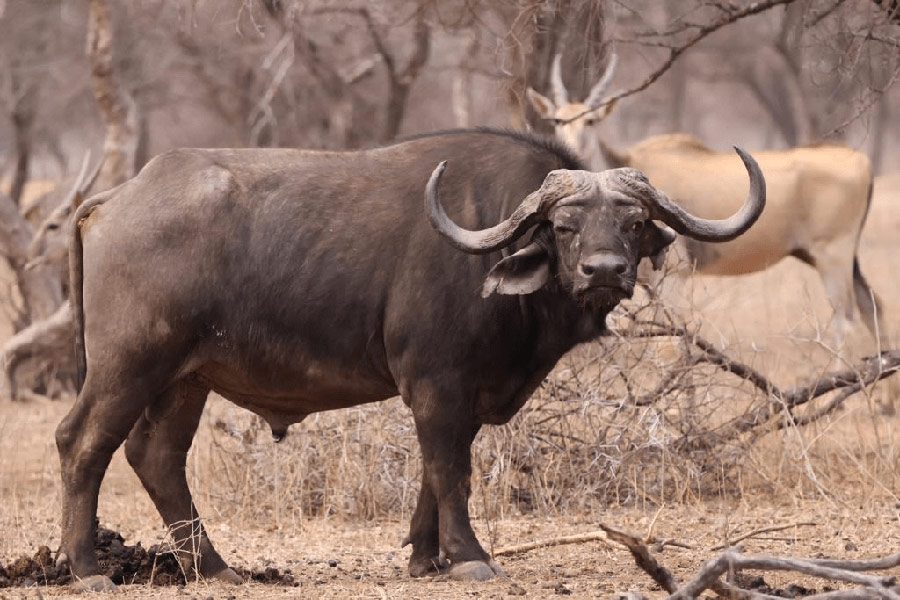
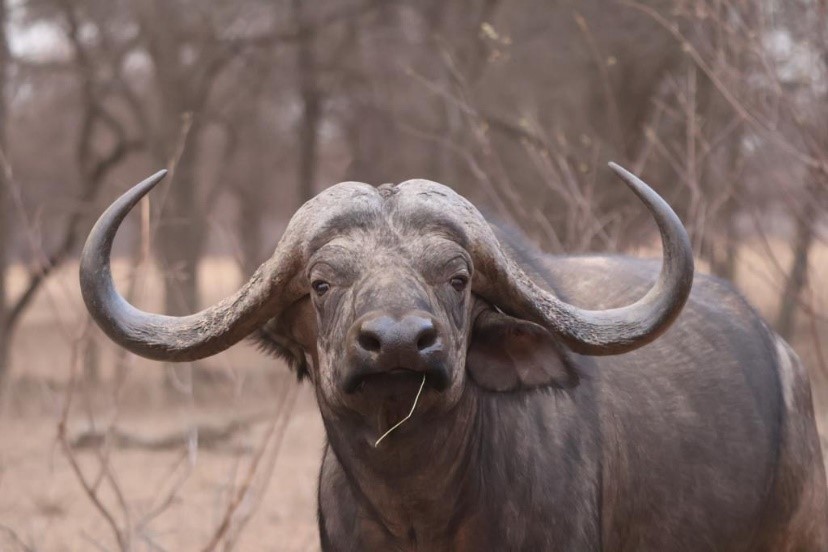
Price for Hunting Buffalos in Africa
When buffalo hunting in Africa, the prices of a forest buffalo are $ 9,000-$ 15,000, depending on the size of the trophy. Savanna buffalo generally range between $ 4,000-$ 20,000 for average and mature animals, depending on the size of the trophy and the sex of the animal. Many game hunting prices are based on wildlife auction prices, where animals are sold live within the South African game industry. While there are magnificent buffalos available for African buffalo hunts, these animals also come with a significant price tag! Pricing can be determined according to the width of the buffalo’s horns:
36”= $4 000
40”= $6 000
42”= $7 000
45”= $10 000
47”= $13 000
48”= $26 000
49”= $40 000
50”= $52 000
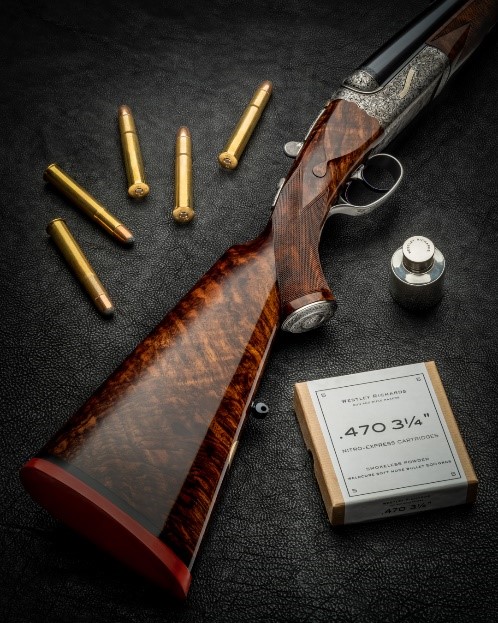
Best Destinations for African Buffalo Hunts
For Forest Buffalo Hunting, the best destinations are the Democratic Republic of the Congo, Angola, Cameroon, and Gabon. These countries are all home to lush forest areas which forest buffalos inhabit. Hunting conditions in these forests will be humid, remote, and significantly challenging. For the pursuit of the Savanna Buffalo, there are numerous countries in which to do so. South Africa is arguably one of the most attractive destinations for buffalo hunting in Africa, along with Namibia, Zimbabwe, and Mozambique. These four countries are home to some truly spectacular buffalo and are beautiful countries for game hunting safaris.
Buffalo hunting in Africa is not for the faint-hearted, and a very challenging hunt! But the rewards far outweigh the challenges when hunting this dangerous and exceptional trophy.
